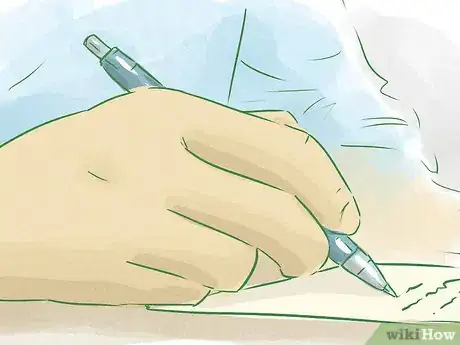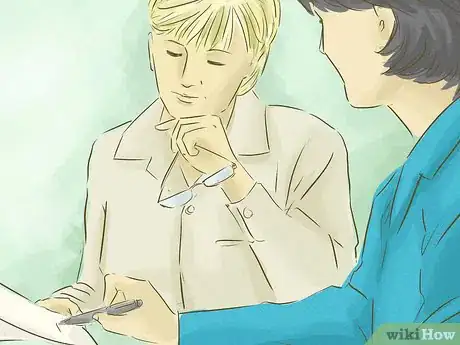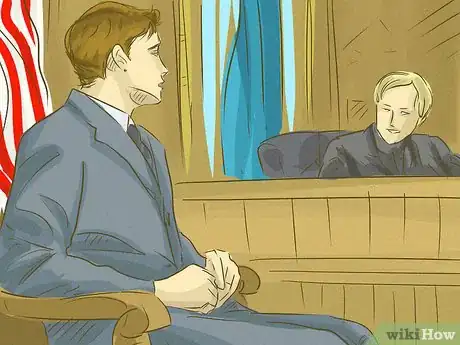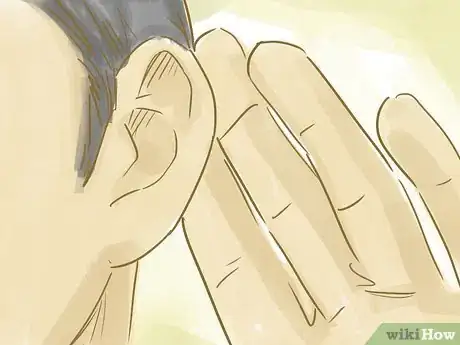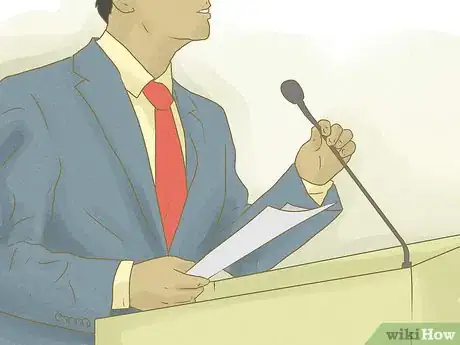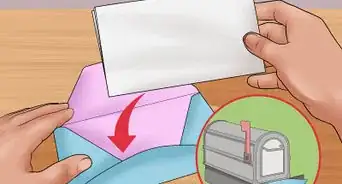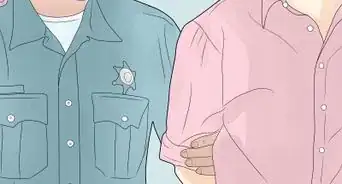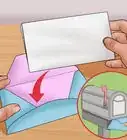This article was written by Jennifer Mueller, JD. Jennifer Mueller is an in-house legal expert at wikiHow. Jennifer reviews, fact-checks, and evaluates wikiHow's legal content to ensure thoroughness and accuracy. She received her JD from Indiana University Maurer School of Law in 2006.
There are 11 references cited in this article, which can be found at the bottom of the page.
This article has been viewed 75,402 times.
If you're facing assault charges,[1] it means you acted in such a way that someone believed, or was afraid, that you were about to hit them. Usually it's charged together with battery, which means you did hit somebody. However, it is possible to be charged just with assault, meaning that you were about to hit someone, and maybe even took a swing at them, but you never connected. The biggest issue is intent: You must intend to cause someone harm to be guilty of assault. Your defenses fall into two major groups: either you argue you didn't commit the offense at all, or you argue that you did commit the offense, but it was for a good reason.[2]
Steps
Analyzing the Charges
-
1Learn the exact elements of the offense. Since assault is defined differently in nearly every jurisdiction, find out what the legal elements are so you know what the prosecution will have to prove.
- Generally, assault comes before battery. You assault someone if you put them in fear that you are imminently going to strike them physically, with the intent to hurt them.[3] Although it seems like an attempted crime, it actually is a complete crime in and of itself.[4]
- If you were in a fight, you probably would be charged with assault and battery. However, it's not uncommon for you to be charged with assault by itself, for example, if you were about to fight someone but the fight was broken up by bystanders or law enforcement.
- In any jurisdiction, to be guilty of assault, the prosecutor must show that you were acting in a deliberately threatening manner that gave the other person a reasonable fear of immediate bodily harm. That fear cannot be a result of your general reputation, or because of a past event.[5]
-
2Tell the story from your perspective. As soon as you learn of the charges against you, think back to the incident and write everything down as well as you can remember it.
- For example, suppose you're in a bar and you accidentally spill a beer on another patron. He gets angry and claims you did it on purpose. Later that night you see him harassing a young woman and come to her defense. The man refuses to back off and you nearly have to punch him, but security intervenes and drags him out.
- If that man later charges you with assault, you have several possible defenses. If his assault charges include the drink being spilled, you obviously do not have the requisite intent because that was an accident. In the second incident, you were defending the young woman. Typically defense of others also is a defense against assault.
- In those situations, the defenses cover both major types of defense. In the first, you're arguing you didn't commit the crime at all, because the element of intent was missing. You couldn't have intended to harm the guy, because it was an accident. In the second, you're admitting that you did commit the crime – you tried to hit him with the intent to harm him – but it was because you were coming to the defense of the young woman he was harassing.
Advertisement -
3Talk to any witnesses. If anyone else saw the incident or altercation, see if they're willing to talk to you about it.
- Especially if you had friends with you when the incident occurred, talk to them as soon as possible and see if they'd be willing to testify on your behalf.
- It's important to round up possible witnesses as soon as possible, while memories of the event are still relatively fresh in people's minds.
-
4Find out why charges were filed. If you can, talk to friends or witnesses and see if they can provide some insight into the motivation behind the charges.
- Understanding the motivation of the alleged victim also can help you formulate your defense against the charges.
- You can even play armchair psychologist a little. To return to the previous example, the guy in the bar may want to put the blame on you to lessen his own guilt – for threatening the young woman, or for drinking too much and getting out of hand generally.
Preparing Your Defenses
-
1Understand the prosecutor's burden of proof. The prosecutor must prove that you are guilty beyond a reasonable doubt, which is a very high standard. You do not have to prove that you didn't do anything.
- If you were only charged with assault, this makes your job a little easier, because there was no actual harm.
- No matter what, you are innocent until proven guilty. This means you haven't assaulted anyone until the prosecutor proves that you've done it. If there's even a shred of reasonable doubt about your guilt, you cannot be convicted of the crime.[6]
-
2Talk to your attorney. In any criminal case, having an attorney is important – so important that you are guaranteed one by the Constitution.[7] [8]
- If you cannot afford an attorney, the court will appoint one for you when you are arraigned and formally charged with the crime.[9] Keep in mind, however, that if the court looks at your finances and decides that you can afford an attorney, you'll have to shell out for your defense on your own.[10]
- Regardless of whether you hire an attorney or use court-appointed counsel, you should always have an attorney when you are facing criminal charges.[11]
-
3Get all statements and other documents from the prosecutor. Analyzing all the evidence the prosecutor has of the crime will help you find areas where you can raise reasonable doubt.
- This is the part of criminal procedure known as discovery, and as the defendant, you are entitled to see all evidence the prosecution has and intends to use against you.
- Unlike on television, the prosecution cannot spring surprise evidence on you in trial.[12]
-
4Develop your own defense. Looking at the law and the circumstances of your case, decide how you're going to approach the defense and nail down your general strategy.
- To be guilty of assault, the prosecutor must prove beyond a reasonable doubt that you acted in a threatening way that produced in the alleged victim the fear that you were going to cause physical harm, and that you intended to cause physical harm.[13]
- In some cases you may be able to defend yourself by proving that one of these elements isn't present. For example, if you have a reputation as a hot-head and someone bumps into you on the street, he may be afraid that you're going to hit him. However, if you simply smile and say "excuse me," you have not committed assault – even if he was afraid – because you made no threatening actions in that moment.[14]
- You also can claim various affirmative defenses. These are defenses that acknowledge that you committed the crime, but assert that you had a legitimate reason for doing so. Self defense is most commonly raised by defendants charged with assault.
- Affirmative defenses have their own elements. For example, if you're claiming self defense, you must show that it is more likely true than not true (called a preponderance of the evidence standard) that there was a threat of force or harm against you, that you feared you were about to be harmed. There is a legal principle in many states called "Stand Your Ground", where you are not required to retreat from an attack. [15]
- In the bar example, you probably could not argue self defense, because you initiated the altercation (at least the second time, with the young woman), and you had plenty of means of escape (you could have not gone over there and engaged the man in the first place).
- You can, however, argue that your actions were taken in defense of others. While similar to self-defense, in this case you have a reasonable fear of harm to someone else.[16] In the case of the example, the young woman would be the person you were defending.
-
5Stay out of trouble while you're waiting for trial. It may not be noticeable that you avoided any further brushes with the law, but it will certainly be noticeable if you get arrested again in the interim, or if you have other charges pending.
Going to Trial
-
1Appear at all scheduled court dates. When you appear in court, make sure you arrive on time, with clean professional dress and a calm demeanor.
- Since the crime is assault, you begin your defense by always appearing as calm and non-threatening as possible when you appear in court. Don't strut around or act tense or touchy, and keep a low profile.
- Be polite and relatively soft spoken, only speaking to the judge or to courtroom staff if they speak to you first.
-
2Listen to the prosecution's witnesses. The prosecution will get to present its case first. Don't interrupt anyone or speak directly to the witnesses or the prosecutor.[17]
- If you hear anything that you disagree with, make a note or mention it to your attorney so she can question the witness about it on cross-examination – but try to be subtle and don't draw undue attention to yourself or interrupt the proceedings.
- After the prosecutor calls each witness to the stand, your attorney has the chance to talk to that witness when the prosecutor is done asking questions. This is known as cross-examination.
- When your attorney is finished, the prosecutor has an opportunity to ask a few more questions that relate to or clarify anything the witness said to your attorney on cross-examination.[18]
-
3Present your own witnesses. After the prosecutor presents the state's case, you will have the opportunity to present your case and have witnesses speak about your side of the story.
- As with the witnesses for the prosecution, the prosecutor also has the opportunity to cross-examine your witnesses.[19]
-
4Testify on your own behalf. If necessary, take the stand yourself and tell the story of the incident from your point of view.
- Sometimes, with assault charges, you may be your greatest defense. Intent is a major element of assault, and it deals with thoughts in your own head. You may have to take the stand to state under oath that you had no intent of harming the other person.
-
5Answer questions from the prosecutor. If you take the stand, the prosecutor has the right to cross-examine you.
- Keep your answers short and to the point, and only answer the question asked directly. For example, if the prosecutor asks you a question that can be answered "yes" or "no," give the one word answer. Don't elaborate or volunteer any more information than the prosecutor asks you for.
-
6Accept or appeal the final judgment. After the prosecution and defense have rested their cases, the case will go to jury or judge for deliberation and final verdict.
- Even after the trial is over, remain calm and accept the verdict. If you're found guilty, you can talk to your attorney about filing an appeal, but it's important to maintain a calm, unruffled appearance in the courtroom.
References
- ↑ http://www.criminaldefenselawyer.com/topics/suspect-defendant-facing-charges
- ↑ http://legal-dictionary.thefreedictionary.com/Assault+and+Battery
- ↑ http://legal-dictionary.thefreedictionary.com/Assault+and+Battery
- ↑ https://www.law.cornell.edu/wex/assault_and_battery
- ↑ http://www.nolo.com/legal-encyclopedia/assault-battery-aggravated-assault-33775.html
- ↑ http://criminal.findlaw.com/criminal-law-basics/defending-yourself-against-a-criminal-charge.html
- ↑ http://www.criminaldefenselawyer.com/resources/criminal-defense/violent-crime/falsely-accused-assault.htm
- ↑ http://www.criminaldefenselawyer.com/topics/legal-representation-charged-crime
- ↑ http://www.criminaldefenselawyer.com/resources/arraignment-basics.htm
- ↑ http://www.criminaldefenselawyer.com/topics/legal-representation-charged-crime
- ↑ http://www.criminaldefenselawyer.com/resources/criminal-defense/violent-crime/falsely-accused-assault.htm
- ↑ http://www.nolo.com/legal-encyclopedia/what-when-the-prosecution-must-disclose.html
- ↑ http://criminal.findlaw.com/criminal-charges/assault-and-battery-defenses.html
- ↑ http://www.nolo.com/legal-encyclopedia/assault-battery-aggravated-assault-33775.html
- ↑ http://criminal.findlaw.com/criminal-charges/assault-and-battery-defenses.html
- ↑ http://criminal.findlaw.com/criminal-charges/assault-and-battery-defenses.html
- ↑ http://www.nolo.com/legal-encyclopedia/criminal-trial-procedures-overview-29509.html
- ↑ http://www.nolo.com/legal-encyclopedia/criminal-trial-procedures-overview-29509.html
- ↑ http://www.nolo.com/legal-encyclopedia/criminal-trial-procedures-overview-29509.html
About This Article
Assault charges can be serious, but with a little preparation, you can help defend yourself. If you’re being charged with assault, it usually means that you acted in a way that made someone believe you would hit them or hurt them. If you’re also being charged with battery, this means that you did cause them bodily harm. While preparing your defenses, you should talk to your attorney to see what the best approach is. If you can’t afford an attorney the state will appoint a free one for you. Likely, you’ll need to recount what happened from your perspective, talk to witnesses, and provide any evidence that makes you seem more favorable. For instance, if the other person started the fight, and a witness saw this, you could use this information to help you get the charges dropped. To learn how to prepare for your trial read more from our Law co-author.

